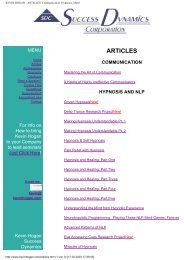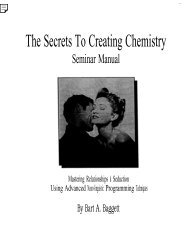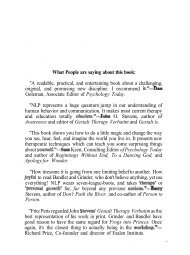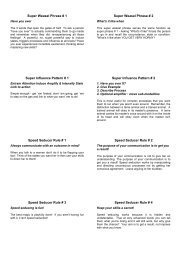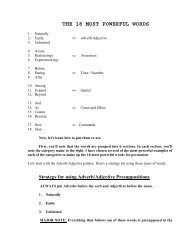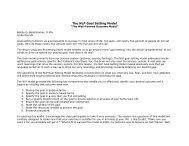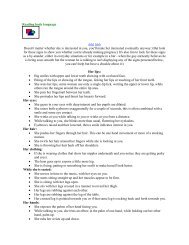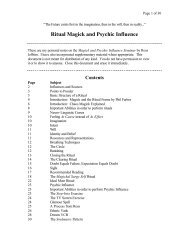A Pragmatic Guide To Communication & Change.pdf - NLP Info Centre
A Pragmatic Guide To Communication & Change.pdf - NLP Info Centre
A Pragmatic Guide To Communication & Change.pdf - NLP Info Centre
- No tags were found...
Create successful ePaper yourself
Turn your PDF publications into a flip-book with our unique Google optimized e-Paper software.
and distortion covered in Chapter I.<br />
Meta Model Violations<br />
Any time you are reading or listening to a person speak and yuo find yourself having to<br />
"go inside" to understand what is Ix ing said, it is a pretty good indication that you have<br />
experienced what is called a "Met. Model violation." The fact that you are confused and<br />
need to internally<br />
for, functions by transforming both the instructions and the data into numbers (symbols).<br />
These arbitrarily assigned symbols make possible the compilation or manipulation of<br />
information. Digital computers are often equated with logical functions and can<br />
demonstrate such relationships as "if then" and the simple negation "not."<br />
The analog computer operates on a program through which it runs information (input) in<br />
order to obtain results. This process orientation enables it to work with and measure<br />
quantities on an continuum such as intensity, weight, or turns of a wheel. From a<br />
bathroom scale or slide rule to the sophisticated guidance system of a rocket, the key to<br />
the analog computer is its manipulations of the analogs of data. 'these analogs are the<br />
similarities between data and its representations (like the number of turns of the<br />
numbered wheel on the bathroom scale), and these similarities are directly related to the<br />
data.<br />
In the "human computer," both systems function conjointly. The differences, however, are<br />
important. The key to digital expression (language) is the arbitrary assignment of wordsymbols<br />
to things or processes. There is no necessary connection between the name and<br />
the thing named. On the contrary, analog, by definition, means that something is similar<br />
to something else. Therefore, we can expect that analogic "language" or communication<br />
will more closely relate to what it is about.<br />
For example, if we hear the word "eat" in an unfamiliar language, we are not likely to<br />
understand it. It is merely an arbitrarily assigned (digital) symbol for a common behavior.<br />
If, however, the person pantomimes the behavior (eating), that is, uses analogic<br />
communication, the meaning is much more likely<br />
to be understood.<br />
But where analogic communication is more universal (and more "primitive"'), it is<br />
also limited in some very important ways. Since analogic communication can only<br />
portray a thing or an action, it cannot portray a thought or idea and is therefore<br />
unable to portray negation. Only the more abstract and versatile digital representation<br />
system can express negation. The digital system can also convey time and number<br />
manipulations which analog systems cannot.<br />
Another limitation is that of ambiguity. A smile (analog) can come from an<br />
experience of pleasure or an experience of pain ("Grin and bear it"). A shrug of the<br />
shoulders can mean "I give up," "I don't care," ,' , I don't know.",lust as with the<br />
analogic computer, there is always some error in translation, and in human analog<br />
systems there are no qualifiers to indicate which message is implied. 2<br />
By understanding the value of the mechanisms involved in the process of affixing labels<br />
to our experiences, we can become more alert to some of the effects these Labels have..<br />
our perception. It is not unusual to judge behavior by its appearance, attaching a name or<br />
label to it and more or less "reifying"it. This tends to halt or at least limit future<br />
observations of the behavior's effects. Dr. Palazzoli talks about this problem in the book



